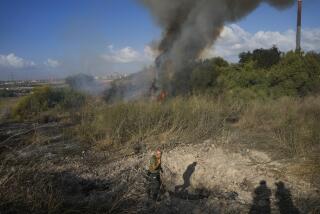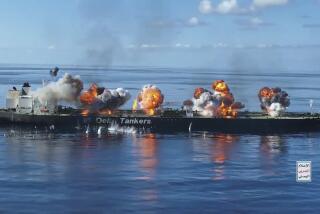Airstrikes hit key Yemen port; rights group condemns civilian casualties

A boy rolls a canister of gas he bought on Aug. 18 after waiting for hours in Sana, Yemen, where ongoing fighting has caused widespread shortages.
Warplanes from a Saudi-led coalition on Tuesday struck a rebel-held port that has been a key gateway for aid entering battered Yemen, even as a major human rights group declared that some of the mounting civilian casualties in the nearly five-month conflict probably amounted to war crimes.
Fighting also raged Tuesday in the central city of Taiz, seen as the last main obstacle to forces loyal to the internationally recognized government pushing north to strike at the capital, Sana. Shiite Muslim Houthi rebels have been entrenched in Sana for nearly a year, and a struggle between heavily armed combatants within its confines would be expected to take a heavy civilian toll.
Civilian deaths and injuries came under scrutiny in a new report by London-based Amnesty International, which cited a “gruesome and bloody trail of death and destruction” in cities including Taiz and Aden, the southern port recently wrested from the Houthis by forces loyal to President Abdu Rabu Mansour Hadi.
The Saudi-led coalition’s self-declared aim is Hadi’s reinstatement after he was forced to flee Yemen early this year. However, international organizations have repeatedly pointed to the conflict’s horrifying cost in human suffering in what was already the Arab world’s poorest country. The fighting has killed more than 4,300 people, about half of them thought to be civilians.
Amnesty International blamed all sides for causing the killing and maiming of noncombatants, but focused its latest investigation on eight coalition airstrikes in and near Taiz and Aden that it said had killed 141 civilians, children among them, and ground fighting that killed an additional 68 noncombatants.
Civilians “have found themselves trapped in a deadly crossfire between Houthi loyalists and anti-Houthi groups on the ground, while facing the persistent threat of coalition airstrikes from the sky,” said Donatella Rovera, the rights group’s senior crisis response advisor. “All the parties to this conflict have displayed a ruthless and wanton disregard for the safety of civilians.”
Indignities persist even after death. The International Committee of the Red Cross said Tuesday that hundreds of corpses were being abandoned in Yemen’s conflict zones because it was too unsafe for loved ones to collect them — a wrenching blow for bereaved families who want to follow the Islamic tradition of speedy burials. The Red Cross said it had retrieved more than 400 bodies since March.
“International humanitarian law requires that dead bodies be treated properly and with respect,” it said in a statement.
In addition to growing numbers of people left dead and injured by combat, the conflict has been marked by the spread of rampant hunger and disease as crucial infrastructure is smashed and only small amounts of humanitarian aid are able to enter the country.
Tuesday’s airstrikes on the Red Sea port of Hodeida, about 90 miles southwest of Sana, destroyed or damaged storage hangars, cargo containers, loading cranes, docking facilities and at least one vessel, officials and witnesses said. The strike could further impede the flow of emergency supplies to Yemen’s north.
There was no immediate comment from the Saudi-led coalition on the targeting of the port area.
In its investigation, Amnesty International said it had found a number of strikes staged in civilian population centers with no evident military target in the area. Some of those, it said, may amount to war crimes because of their seemingly indiscriminate nature.
Despite months of concerted airstrikes, the Saudi-led coalition has only in recent weeks made significant headway against the Houthis and their allies, some of them military units loyal to former strongman Ali Abdullah Saleh, who was ousted from power in 2011. Forces loyal to Hadi claim to have driven the Houthis out of much of the country’s south; the rebels say they staged a strategic retreat.
Both Yemen’s Al Qaeda affiliate, known as Al Qaeda in the Arabian Peninsula, and the militants of the Islamic State have benefited from the chaos, moving into parts of the country where they previously did not operate. In recent days, videos have been released showing Al Qaeda and Islamic State fighters slaughtering prisoners.
Sectarian tensions lie at the root of the fighting. Saudi Arabia and its Persian Gulf allies launched the air war on March 26 in a bid to check what they see as a growing influence by Shiite Muslim Iran, which denies arming the rebels but has bitterly denounced the campaign led by Sunni Muslim-dominated Saudi Arabia.
Special correspondent Al-Alayaa reported from Sana and staff writer King from Cairo.
Follow @laurakingLAT on Twitter for news out of the Middle East
More to Read
Sign up for Essential California
The most important California stories and recommendations in your inbox every morning.
You may occasionally receive promotional content from the Los Angeles Times.










